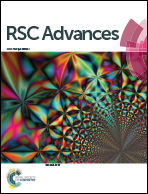Synthesis of hierarchical WO3 nanostructured thin films with enhanced electrochromic performance for switchable smart windows†
Abstract
In our present work, hierarchical WO3 nanostructured thin films were successfully synthesized over pre-deposited seed layered FTO substrates through an electrodeposition method. By adjusting the pH values of the electrolyte, three different morphologies such as nanospindles (W1), nanoplatelets (W2), and hierarchical flower (W3) like nanoarray films have been obtained. The structural, surface, compositional and optical performance of the WO3 nanostructured thin films were characterized by XRD, FESEM, AFM, XPS, UV-VIS and detailed electrochromic functionality was examined by cyclic voltammetry (CV) at different applied potentials. Among the three nanostructured thin film electrodes (W1, W2, W3), W3 exhibits excellent larger optical contrast (79.90% at 550 nm), faster switching response time (tb = 3.82 s and tc = 5.05 s), and superior coloration efficiency (172.08 cm2 C−1) with stability over 2000 cycles. The synthesized WO3 electrode (W3) with flower morphology shows excellent reversibility of around 94.11% compared to the other nanostructures (W1 and W2) due to its enhanced crystallinity and high porosity. Our results suggest that flower-like WO3 nanostructured thin film electrodes will have a great impact on large scale production and make the material a promising candidate for fabrication of efficient electrochromic devices.


 Please wait while we load your content...
Please wait while we load your content...